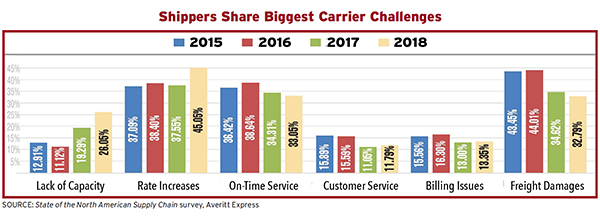Despite Challenges, Shippers Forge Ahead

Shippers experienced a range of supply chain challenges in 2018, according to results from Averitt Express’ fourth annual State of the North American Supply Chain survey. More than 2,300 North American shippers from a variety of industries participated.
The results provide a clear view of the road that shippers traveled in the previous year. The findings, as they relate to 2018, may not come as a big surprise to many who had a direct involvement in supply chain management. Nonetheless, they confirm that certain issues were widespread. At the same time, the feedback illustrates the service challenges shippers experienced and how they chose to react.
Ultimately, tight capacity and increasing freight costs were the bane of 2018. Boosted by a consumer recovery that began in 2017, supply chain operations were at the same time hindered as the trucking industry adjusted to the electronic logging device mandate that went into effect in late 2017.
When Averitt asked shippers about their outlook on¨the state of supply chains in 2019, there was a stark contrast from the year before. The results show a rising anticipation that shipping volumes will head downward. From an economic standpoint, the results correlate with analysts’ general predictions.
Last year was also a hot one for most industries
 that experienced relief from tax overhauls. This year, however, the steam may start to escape as worries about international trade relations continue to grow.
Among the key findings:
- 26.05 percent of shippers experienced challenges with freight capacity in 2018.
- 69.59 percent expect to ship more freight in 2019 than last year—a 6.3 percentage point decrease from the previous year’s survey.
- 41 percent view trade tariffs as having a negative impact on their business in 2018, compared to only 5 percent who report positive effects.
From the driver shortage to trade wars, shippers faced challenges at nearly every point in the supply chain. While perception of the near-term economy may indicate a slowdown in freight movement is looming, shippers and carriers should not dismiss past challenges.
Freight capacity will likely remain a hurdle for shippers for years to come. The driver shortage continues to grow and will likely carry on for the foreseeable future. To that note, plan ahead as much as possible and work closely with your transportation partners. Two-way communication will be crucial to the success of both shippers and carriers.
As the year continues, all eyes will be focused on the state of international trade. Reshoring and nearshoring of manufacturing may see a surge as more businesses look to bypass the increased costs of managing a global supply chain.
At the same time, we may also look forward to a year that could usher in new agreements that will help businesses grow both at home and abroad.

When Averitt asked shippers what kind of impact trade tariffs had on their business in 2018, the response was a stark contrast to the perceptions gauged in 2016. A majority said the negative impact was higher supply chain costs. One key issue that importers experienced is the inability to find more cost-efficient domestic sources for raw materials and products.
